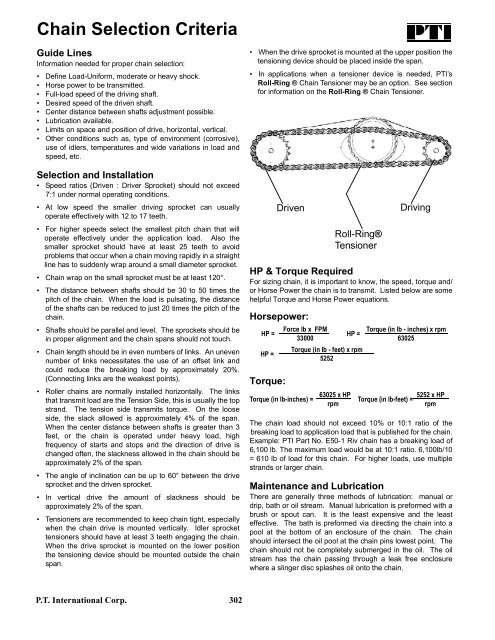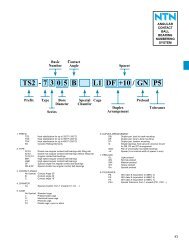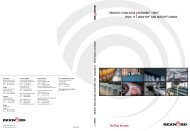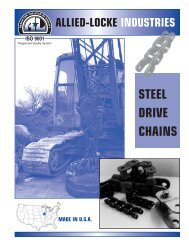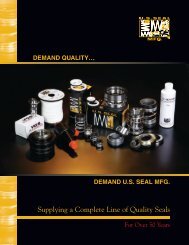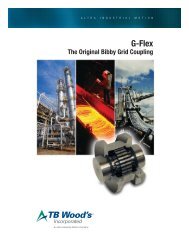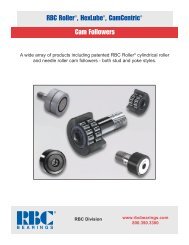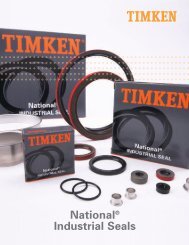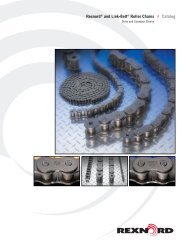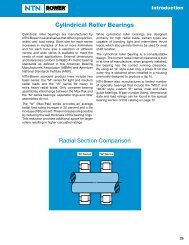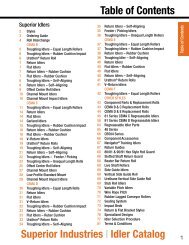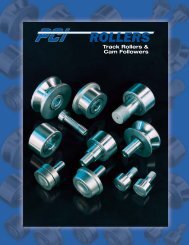PTI Bearing Catalog - Norfolkbearings.com
PTI Bearing Catalog - Norfolkbearings.com
PTI Bearing Catalog - Norfolkbearings.com
Create successful ePaper yourself
Turn your PDF publications into a flip-book with our unique Google optimized e-Paper software.
Chain Selection Criteria<br />
Guide Lines<br />
Information needed for proper chain selection:<br />
• Define Load-Uniform, moderate or heavy shock.<br />
• Horse power to be transmitted.<br />
• Full-load speed of the driving shaft.<br />
• Desired speed of the driven shaft.<br />
• Center distance between shafts adjustment possible.<br />
• Lubrication available.<br />
• Limits on space and position of drive, horizontal, vertical.<br />
• Other conditions such as, type of environment (corrosive),<br />
use of idlers, temperatures and wide variations in load and<br />
speed, etc.<br />
Selection and Installation<br />
• Speed ratios (Driven : Driver Sprocket) should not exceed<br />
7:1 under normal operating conditions.<br />
• At low speed the smaller driving sprocket can usually<br />
operate effectively with 12 to 17 teeth.<br />
• For higher speeds select the smallest pitch chain that will<br />
operate effectively under the application load. Also the<br />
smaller sprocket should have at least 25 teeth to avoid<br />
problems that occur when a chain moving rapidly in a straight<br />
line has to suddenly wrap around a small diameter sprocket.<br />
• Chain wrap on the small sprocket must be at least 120°.<br />
• The distance between shafts should be 30 to 50 times the<br />
pitch of the chain. When the load is pulsating, the distance<br />
of the shafts can be reduced to just 20 times the pitch of the<br />
chain.<br />
• Shafts should be parallel and level. The sprockets should be<br />
in proper alignment and the chain spans should not touch.<br />
• Chain length should be in even numbers of links. An uneven<br />
number of links necessitates the use of an offset link and<br />
could reduce the breaking load by approximately 20%.<br />
(Connecting links are the weakest points).<br />
• Roller chains are normally installed horizontally. The links<br />
that transmit load are the Tension Side, this is usually the top<br />
strand. The tension side transmits torque. On the loose<br />
side, the slack allowed is approximately 4% of the span.<br />
When the center distance between shafts is greater than 3<br />
feet, or the chain is operated under heavy load, high<br />
frequency of starts and stops and the direction of drive is<br />
changed often, the slackness allowed in the chain should be<br />
approximately 2% of the span.<br />
• The angle of inclination can be up to 60° between the drive<br />
sprocket and the driven sprocket.<br />
• In vertical drive the amount of slackness should be<br />
approximately 2% of the span.<br />
• Tensioners are re<strong>com</strong>mended to keep chain tight, especially<br />
when the chain drive is mounted vertically. Idler sprocket<br />
tensioners should have at least 3 teeth engaging the chain.<br />
When the drive sprocket is mounted on the lower position<br />
the tensioning device should be mounted outside the chain<br />
span.<br />
• When the drive sprocket is mounted at the upper position the<br />
tensioning device should be placed inside the span.<br />
• In applications when a tensioner device is needed, <strong>PTI</strong>’s<br />
Roll-Ring ® Chain Tensioner may be an option. See section<br />
for information on the Roll-Ring ® Chain Tensioner.<br />
HP & Torque Required<br />
For sizing chain, it is important to know, the speed, torque and/<br />
or Horse Power the chain is to transmit. Listed below are some<br />
helpful Torque and Horse Power equations.<br />
Horsepower:<br />
HP =<br />
HP =<br />
Torque:<br />
Driven<br />
Roll-Ring®<br />
Tensioner<br />
Force lb x FPM<br />
Torque (in lb - inches) x rpm<br />
HP =<br />
33000 63025<br />
Torque (in lb - feet) x rpm<br />
5252<br />
Driving<br />
Torque (in lb-inches) = 63025 x HP 5252 x HP<br />
Torque (in lb-feet) =<br />
rpm rpm<br />
The chain load should not exceed 10% or 10:1 ratio of the<br />
breaking load to application load that is published for the chain.<br />
Example: <strong>PTI</strong> Part No. E50-1 Riv chain has a breaking load of<br />
6,100 lb. The maximum load would be at 10:1 ratio. 6,100lb/10<br />
= 610 lb of load for this chain. For higher loads, use multiple<br />
strands or larger chain.<br />
Maintenance and Lubrication<br />
There are generally three methods of lubrication: manual or<br />
drip, bath or oil stream. Manual lubrication is preformed with a<br />
brush or spout can. It is the least expensive and the least<br />
effective. The bath is preformed via directing the chain into a<br />
pool at the bottom of an enclosure of the chain. The chain<br />
should intersect the oil pool at the chain pins lowest point. The<br />
chain should not be <strong>com</strong>pletely submerged in the oil. The oil<br />
stream has the chain passing through a leak free enclosure<br />
where a slinger disc splashes oil onto the chain.<br />
P.T. International Corp. 302


